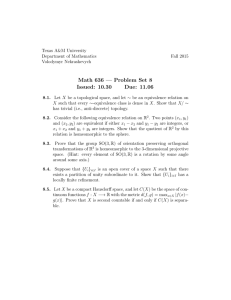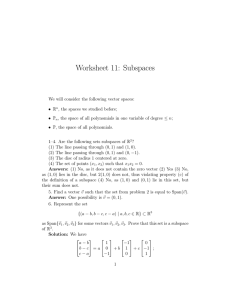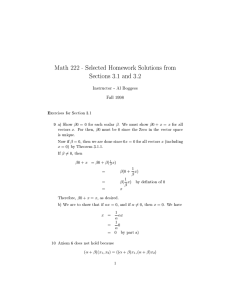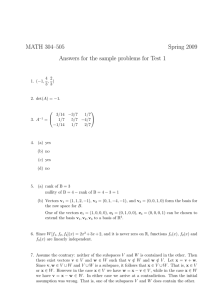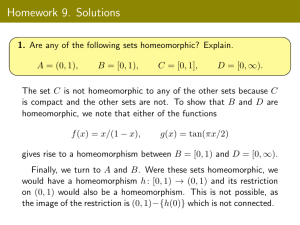Proceedings of the Ninth Prague Topological Symposium
advertisement
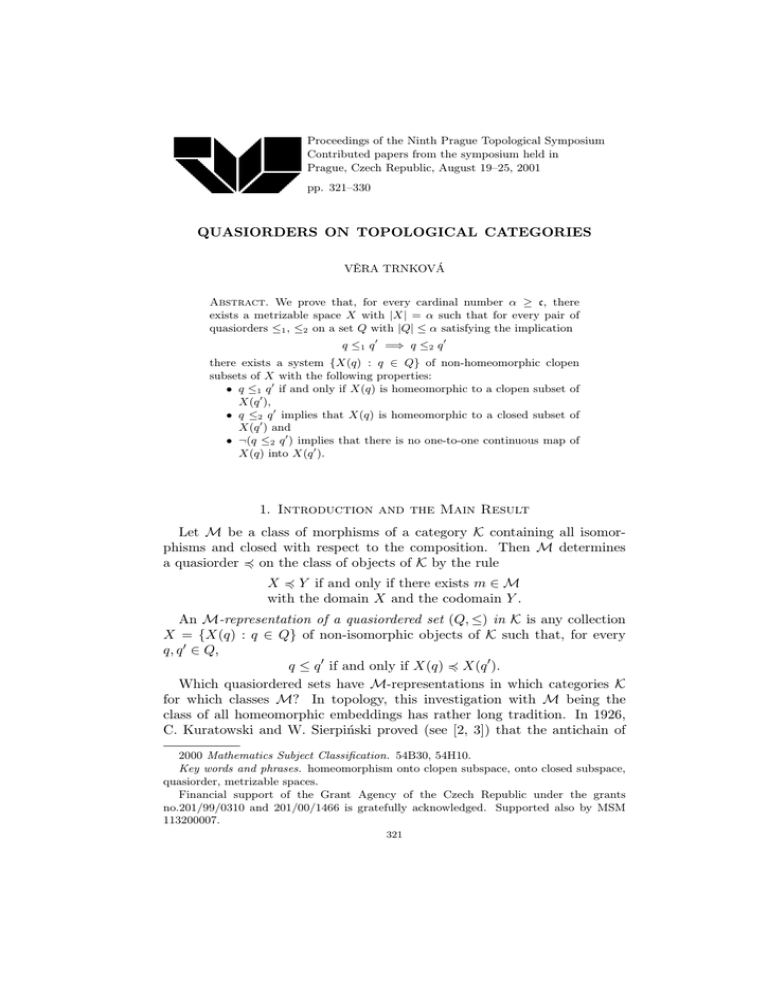
Proceedings of the Ninth Prague Topological Symposium
Contributed papers from the symposium held in
Prague, Czech Republic, August 19–25, 2001
pp. 321–330
QUASIORDERS ON TOPOLOGICAL CATEGORIES
VĚRA TRNKOVÁ
Abstract. We prove that, for every cardinal number α ≥ c, there
exists a metrizable space X with |X| = α such that for every pair of
quasiorders ≤1 , ≤2 on a set Q with |Q| ≤ α satisfying the implication
q ≤1 q 0 =⇒ q ≤2 q 0
there exists a system {X(q) : q ∈ Q} of non-homeomorphic clopen
subsets of X with the following properties:
• q ≤1 q 0 if and only if X(q) is homeomorphic to a clopen subset of
X(q 0 ),
• q ≤2 q 0 implies that X(q) is homeomorphic to a closed subset of
X(q 0 ) and
• ¬(q ≤2 q 0 ) implies that there is no one-to-one continuous map of
X(q) into X(q 0 ).
1. Introduction and the Main Result
Let M be a class of morphisms of a category K containing all isomorphisms and closed with respect to the composition. Then M determines
a quasiorder 4 on the class of objects of K by the rule
X 4 Y if and only if there exists m ∈ M
with the domain X and the codomain Y .
An M-representation of a quasiordered set (Q, ≤) in K is any collection
X = {X(q) : q ∈ Q} of non-isomorphic objects of K such that, for every
q, q 0 ∈ Q,
q ≤ q 0 if and only if X(q) 4 X(q 0 ).
Which quasiordered sets have M-representations in which categories K
for which classes M? In topology, this investigation with M being the
class of all homeomorphic embeddings has rather long tradition. In 1926,
C. Kuratowski and W. Sierpiński proved (see [2, 3]) that the antichain of
2000 Mathematics Subject Classification. 54B30, 54H10.
Key words and phrases. homeomorphism onto clopen subspace, onto closed subspace,
quasiorder, metrizable spaces.
Financial support of the Grant Agency of the Czech Republic under the grants
no.201/99/0310 and 201/00/1466 is gratefully acknowledged. Supported also by MSM
113200007.
321
322
VĚRA TRNKOVÁ
the cardinality 2c and the ordinal c+ have such representations within the
category of all subspaces of the real line R. In 1993, P.T. Matthews and
T.B.M. McMaster refreshed this field of problems and proved (see [5]) that
every partially ordered set of the cardinality c has such representation. In
1999, A.E. McCluskey, T.B.M. McMaster and W.S. Watson proved (see [8])
that the set (exp R, ⊆) of all subsets of the real line R ordered by the inclusion also has such a representation, i.e. a representation by subspaces of R
with respect to the embeddability. Since (exp R, ⊆) contains an antichain of
the cardinality 2c , their result implies the first result of C. Kuratowski and
W. Sierpiński. Analogously it implies the previous result of P.T. Matthews
and T.B.M. McMaster because (exp R, ⊆) contains an isomorphic copy of
any partially ordered set of cardinality at most c. The authors of [8] also
announced that they have a counterexample consistent with ZFC to the
statement that every partially ordered set of the cardinality 2c can be represented by subspaces of R with respect to the embeddability. In [6], A.E.
McCluskey and T.B.M. McMaster generalized the construction of [8] and
they proved that, for any infinite cardinal numbers a, b such that ba = b,
every partially ordered set (P, ≤) with |P | ≤ b has a representation (with
respect to the embeddability) by subsets of every T3 -space X containing
a dense subset D with |D| ≤ a whenever every non-empty open set of X has
the cardinality b. Moreover, if X admits a homeomorphism into itself such
that every x ∈ X has an infinite orbit, then every quasiordered set obtained
from a partially ordered set (P, ≤) with |P | ≤ b by splitting every p ∈ P
into 2b mutually comparable points has also such a representation.
Given a cardinal number α, A.E. McCluskey and T.B.M. McMaster also
present (in [7]) a construction of a T0 -space X with |X| = δ(α) such that
every quasiordered set (Q, ≤) with |Q| ≤ α has a representation by subsets of X (with respect to the embeddability), where δ(α) is the smallest
cardinal number δ such that there exist α distinct cardinal numbers γ (not
necessarily infinite) smaller than δ. If α = ℵ0 , then δ(α) = ℵ0 ; hence there
exists a countable T0 -space X such that every countable quasiordered set
has a representation (with respect to the embeddability) by subsets of X.
For α uncountable, the size of X is rather high. The statement below offers
a stronger result for any α ≥ c.
For every cardinal number α ≥ c there exists a metrizable space X with
|X| = α such that every quasiordered set (Q, ≤) with |Q| ≤ α has an Mrepresentation by retracts of X whenever
(1) M consists of one-to-one continuous maps and it contains all coproduct injections (= homeomorphic embeddings onto clopen subspaces)
or
(2) M consists of continuous surjections and it contains all product projections.
The claim (1) implies e.g. the representability of every quasiordered set
(Q, ≤) with |Q| ≤ α by retracts of X with respect to the embeddability or
QUASIORDERS ON TOPOLOGICAL CATEGORIES
323
the embeddability onto closed subspaces or onto retracts or onto clopen subspaces. The claim (2) implies the representability e.g. by being continuous
image or a quotient or a continuous open image or a factor in a product.
Here we prove a result much stronger than (1) above, namely the following.
Theorem. For every cardinal number α ≥ c, there exists a metrizable space
X with |X| = α such that, for every pair ≤1 , ≤2 of quasiorders on a set Q
with |Q| ≤ α satisfying the implication
q ≤1 q 0 =⇒ q ≤2 q 0 ,
there exists a system {X(q) : q ∈ Q} of non-homeomorphic clopen subsets
of X with the following properties:
(1) q ≤1 q 0 if and only if X(q) is homeomorphic to a clopen subset of
X(q 0 ),
(2) q ≤2 q 0 implies that X(q) is homeomorphic to a closed subset of
X(q 0 ) and
(3) ¬(q ≤2 q 0 ) implies that there is no one-to-one continuous map of
X(q) into X(q 0 ).
The proof of this theorem is presented in the part II of the present paper.
Inspecting the proof, one can see that none of the spaces X(q) has an isolated
point. Hence if one adds α isolated points to every X(q) (and also to the
space X), she (he) gets the following result:
For every cardinal number α ≥ c there exists a metrizable space X with
|X| = α such that every quasiordered set (Q, ≤) with |Q| ≤ α has an Mrepresentation by clopen subspaces of X whenever M is the class of all
continuous bijections.
We do not present here the proof of the above claim (2) and of its stronger
variant concerning simultaneous representation of a pair ≤1 , ≤2 of quasiorders by product projections and continuous surjections. The proof will
appear elsewhere.
Finally, let us refresh here some results which have applications in the
present field of problems. In [1], J. Adámek and V. Koubek introduced
a sum-productive representation of a partially ordered commutative semigroups as follows: If (S, ◦, ≤) is a partially ordered commutative semigroup
(i.e. if (S, ◦) is a commutative semigroup and ≤ is a partial order on S such
that
(a ≤ b) and (a0 ≤ b0 ) =⇒ a ◦ a0 ≤ b ◦ b0 ),
then its sum-productive representation in a category K is any collection
{X(s) : s ∈ S} of objects of K such that
(×) X(s ◦ s0 ) is always isomorphic to the product X(s) × X(s0 ) and
(≤) s ≤ s0 if and only if X(s) is isomorphic to a summand of X(s0 ) (i.e.
X(s0 ) is a coproduct of X(s) and an object of K).
In [11], J. Vinárek proved that every partially ordered commutative semigroup has a sum-productive representation in the category of all metric
324
VĚRA TRNKOVÁ
zero-dimensional spaces. Every partially ordered set (P, ≤) can be enlarged
to a partially ordered set (S, ≤) in which every pair of elements has an infimum. Putting p◦p0 = inf{p, p0 }, one gets the partially ordered commutative
semigroup (S, ◦, ≤) and the Vinárek’s result can be applied. Hence
every partially ordered set has a representation by zero-dimensional metrizable spaces with respect to the embeddability onto clopen subspaces.
In [10], sum-productive representations in the category of all Fσδ -and-Gσδ
subspaces of the Cantor discontinuum are examined. Omitting the product
forming again, we get the result that
if C is a countable set, then (exp C, ⊆) has a representation by Fσδ and
Gσδ subspaces of the Cantor discontinuum with respect to the embeddability
onto clopen subspaces.
These scattered results are surrounded by many unsolved questions, such
as: which quasiordered sets can be represented by metrizable zero-dimensional spaces or by closed or Borelian or all subsets of the real line with
respect to the embeddability onto clopen subspaces or onto Borelian subspaces or onto closed subspaces or onto retracts; and many others.
2. Proof of the Theorem
Let α ≥ c be given. Let Q be a set with |Q| = α. In the part A of the
proof, we suppose that we have sets S (1) , . . . , S (4) of metrizable spaces of
cardinality α with the five properties below and we prove Theorem using
such sets. In the part B, we prove that such sets S (1) , . . . , S (4) really do
exist.
Part A.
a. Thus, let us suppose that S (1) , . . . , S (4) are sets of metrizable spaces with
|S (i) | = α and |Y | = α for every Y ∈ S (i) , i = 1, . . . , 4, such that the
statements (1)–(5) below are satisfied:
(1) S (1) = {Aq , Bq : q ∈ Q} are spaces such that, for every q ∈ Q, Aq is
homeomorphic to a clopen subspace of Bq and Bq is homeomorphic
to a closed subspace but to no clopen subspace of Aq ; moreover, if
q 6= q 0 , there exists no continuous one-to-one map of any Aq , Bq into
any Aq0 , Bq0 ;
(2) S (2) = {Dq , Eq : q ∈ Q} are such that Dq is homeomorphic to
a closed subspace of Eq and Eq is homeomorphic to a closed subspace of Dq but there exists no homeomorphism of Dq onto a clopen
subspace of Eq and no homeomorphism of Eq onto a clopen subspace
of Dq ; moreover, if q 6= q 0 , then there exists no continuous one-to-one
map of any Dq , Eq into any Dq0 , Eq0 ;
(3) S (3) = {Mq , Nq : q ∈ Q} are spaces such that Mq is homeomorphic
to a clopen subspace of Nq and Nq is homeomorphic to a closed
subspace but to no clopen subspace of Mq (i.e. they are mutually
QUASIORDERS ON TOPOLOGICAL CATEGORIES
325
situated as Aq and Bq in (1)); moreover, if q 6= q 0 , there exists no
continuous one-to-one map of any Mq , Nq into any Mq0 , Nq0 ;
(4) S (4) = {Gq , Hq : q ∈ Q} are spaces such that Gq is homeomorphic
to a clopen subspace of Hq and Hq is homeomorphic to a clopen
subspace of Gq but Gq is not homeomorphic to Hq ; moreover, if
q 6= q 0 , there exists no continuous one-to-one map of any Gq , Hq into
any Gq0 , Hq0 ;
(5) if i, j = 1, . . . , 4, i 6= j, Z ∈ S (i) , Y ∈ S (j) , then there exists no
continuous one-to-one map of Z into Y .
We put
a
`
`
`
`
`
`
X=
(Aq Bq (Dq × ω) (Eq × ω) Mq Nq Gq )
q∈Q
a
where and
denote the coproduct (= disjoint union as clopen subspaces)
and ω is a countable discrete space (i.e. Dq × ω is a coproduct of countably
many copies of Dq and analogously for Eq ).
Hence X is a metrizable space and |X| = α. We show that X has all
the required properties. In the reasoning below, we shall frequently use the
statement (5) without mentioning it.
`
b. Let (Q, ≤1 , ≤2 ) be a set with two quasiorders ≤1 , ≤2 such that
q ≤1 q 0 =⇒ q ≤2 q 0 .
To begin with, let us suppose, moreover, that ≤1 is a partial order, i.e.
(q ≤1 q 0 ) and (q 0 ≤1 q) =⇒ q = q 0
(2.1)
(this requirement will be removed at the end of part A of the proof).
By means of S (1) –S (3) , we construct a system {X(q) : q ∈ Q} of clopen
subspaces of X such that
• q ≤1 q 0 if and only if X(q) is homeomorphic to a clopen subset of
X(q 0 ),
• q ≤2 q 0 if and only if X(q) is homeomorphic to a closed subset of
X(q 0 ) and
• if ¬(q ≤2 q 0 ), then there is no continuous one-to-one map of X(q)
into X(q 0 ).
First, let us define < by the rule
q < q 0 if and only if (q ≤1 q 0 ) and (¬(q 0 ≤1 q)) and (q 0 ≤2 q),
and q ≤ q 0 denotes q < q 0 or q = q 0 . (By (2.1), ≤ is a partial order.) Let C
be the system of all components of ≤ (i.e. q, q 0 ∈ C ∈ C if and only if there
exist q0 , . . . , qn in Q such that q = q0 ≤ q1 ≥ q2 ≤ . . . qn = q 0 ).
For every q ∈ C ∈ C put
(1)
Sq = {Bq0 : q 0 ≤ q} ∪ {Aq0 : q 0 ∈ C and ¬(q 0 ≤ q)},
` (1)
(1)
X q = Sq .
326
VĚRA TRNKOVÁ
Moreover, let us denote
BC = {Bq : q ∈ C},
DC = {Dq × ω : q ∈ C},
EC = {Eq × ω : q ∈ C}.
Observation. If q ∈ C and q 0 ∈ C 0 with C, C 0 ∈ C, C =
6 C 0 , then there
(1)
(1)
exists no continuous one-to-one map of Xq into Xq0 . If q, q 0 ∈ C, then
(1)
q < q 0 if and only if Xq
(1)
is homeomorphic to a clopen subspace of Xq0 and
(1)
(1)
Xq0 is homeomorphic to a closed but not to any clopen subspace of Xq .
c. On Q, let us define q R q 0 if and only if either
q < q 0 or
q ≤2 q 0 and q 0 ≤2 q but neither q ≤1 q 0 nor q 0 ≤1 q.
Let ≺ be the transitive envelope of R, and let mean ≺ or =. Then is
a quasiorder on Q; let L be the system of all its components. Clearly, each
C ∈ C is a subset of precisely one L ∈ L. For every q ∈ C ∈ C, C ⊆ L, put
S
(2)
(1)
Sq = Sq ∪
(BC 0 ∪ EC 0 ∪ DC 0 ) ∪ EC ;
C 0 ∈C,C6=C 0 ⊆L
` (2)
(2)
X q = Sq
(2)
(1)
Observation. If q, q 0 ∈ C ∈ C, q 6= q 0 , then Sq differs from Sq
same summand
[
(BC 0 ∪ EC 0 ∪ DC 0 ) ∪ EC
by the
C 0 ∈C,C6=C 0 ⊆L
(2)
(1)
(2)
as Sq0 differs from Sq0 . Hence Xq
(1)
(2)
and Xq0 are in the same relations
(1)
as Xq and Xq0 . If C, C 0 ∈ C, C 6= C 0 and both C, C 0 are subsets of
L ∈ L, q ∈ C, q 0 ∈ C 0 , then Xq is homeomorphic to a closed subspace
but not to any clopen subspace of Xq0 and vice versa. This is because
`
(EC ∪ DC ∪ EC 0 ) is homeomorphic to a closed (but not to any clopen!)
`
` (1)
subspace of (EC 0 ∪ DC 0 ∪ EC ), by (2) (and (Sq ∪ BC 0 ) is homeomorphic
` (1)
to a closed subspace of (Sq0 ∪ BC ), by (1)).
(2)
Hence {Xq
: q ∈ L} is such that
(2)
is homeomorphic to a clopen subset of Xq0
(2)
is homeomorphic to a closed subset of Xq0 .
q ≤1 q 0 if and only if Xq
(2)
and
q ≤2 q 0 if and only if Xq
(2)
(For every q, q 0 ∈ L, we have q ≤2 q 0 and q 0 ≤2 q, of course.) Moreover, if
L, L0 ∈ L, L 6= L0 , q ∈ L, q 0 ∈ L0 , then there exists no one-to-one continuous
map of X(q) into X(q 0 ) and vice versa. Let us denote
(2)
SL = {BC ∪ EC ∪ DC : C ∈ C, C ⊆ L}.
QUASIORDERS ON TOPOLOGICAL CATEGORIES
327
d. On Q, let us define q Ṙq 0 if and only if either
q ≺ q 0 or
q 6= q 0 , q ≤1 q 0 or
q 6= q 0 , q ≤2 q 0 .
˙ mean ≺
˙ be the transitive envelope of Ṙ, and let ˙ or =. Let T be the
Let ≺
˙ Every L ∈ L is a subset of
system of all components of the quasiorder .
precisely one T ∈ T . If L, L0 ∈ L, L 6= L0 , q ∈ L, q 0 ∈ L0 and q ≤2 q 0 , then
˙ determines
for no q̄ ∈ L, q̄ 0 ∈ L0 is q̄ 0 ≤2 q̄ because L 6= L0 . Hence in fact, ˙ For every
a partial order on the components in L, let us denote it also by .
L ∈ L define
[ (2)
Seq(2) =
Se 0
L
˙
L0 ≺L
and for q ∈ L,
(2)
(2)
(2)
Seq = Sq ∪ SeL ,
`
(2)
(2)
eq = Seq .
X
If q ∈ L, q 0 ∈ L0 and L, L0 are components of L incomparable in the partial
eq(2) into X
e (2)
˙ then there is no continuous one-to-one map of X
order ,
q 0 and
(2)
eq is in the same position with respect to
vice versa. If q, q 0 ∈ L, then X
(2)
(2)
(2)
e (2)
e 0 as Xq to X 0 . If q 0 ∈ L0 L
˙ 3 q, then X
is homeomorphic to
X
0
q
q
q
eq(2) and there exists no continuous one-to-one map of
a clopen subspace of X
0
0
eq(2) into X
e (2)
X
q 0 . This is what we need whenever q ≤1 q. However, if q ≤2 q
(2)
eq(2)
and ¬(q 0 ≤1 q), we still have to modify the systems Seq and the spaces X
by means of the spaces in S (3) in (3). For q ∈ L, we put
(3)
(2)
Sq = Seq ∪ {Nq0 : q 0 ∈ T and q 0 ≤1 q} ∪ {Mq0 : q 0 ∈ T and ¬(q 0 ≤1 q)};
` (3)
X(q) = Sq .
First, we outline why these “new summands” do not destroy the mutual
eq(2)
e (2)
position of X
1 and Xq2 whenever q1 , q2 ∈ L ⊆ T :
(3)
• q1 ≤1 q2 : if Nq0 ∈ Sq1 , i.e. q 0 ≤1 q1 , we get q 0 ≤1 q2 so that
(3)
(3)
Nq0 ∈ Sq2 ; since Sq2 always contains either Mq0 or Nq0 , the case
(3)
Mq0 ∈ Sq1 is clear.
(3)
• q1 ≤2 q2 : if Nq0 ∈ Sq1 , i.e. q 0 ≤1 q1 , then either q 0 ≤1 q2 hence Nq0 ∈
(3)
(3)
Sq2 , or ¬(q 0 ≤1 q2 ) hence Mq0 ∈ Sq2 ; but Nq0 is homeomorphic to
a closed subspace of Mq0 .
No other case for q1 , q2 ∈ L is possible (if ¬(q1 ≤ q2 ) for q1 , q2 ∈ L, then
(2)
(2)
already Seq1 is not homeomorphic to a clopen subspace of Seq2 ).
Next we show that the system {X(q) : q ∈ Q} has all the required properties.
328
VĚRA TRNKOVÁ
Let q1 , q2 ∈ Q. If q1 , q2 ∈ L, we have just proved it. If q1 ∈ T, q2 ∈ T 0
where T, T 0 are distinct elements of T (i.e. distinct components of the qua˙ then there is no continuous one-to-one map of X(q1 ) into X(q2 )
siorder ),
or vice versa. But this precisely corresponds to the fact that ¬(q1 ≤2 q2 ) and
¬(q2 ≤2 q1 ). The remaining case is that q1 , q2 are in distinct components
L1 , L2 of L but both L1 and L2 are subsets of a component T ∈ T . We
discuss the following cases:
˙ then there exists
α) L1 and L2 are incomparable in the partial order :
(2)
(2)
eq1 into X
eq2 and adding any
no one-to-one continuous map of X
summands Mq0 , Nq0 cannot change this situation; hence there exists
no continuous one-to-one map of X(q1 ) into X(q2 ) or vice versa.
eq(2)
˙ 2 : hence X
β) let L1 ≺L
is homeomorphic to a clopen subspace of
1
(2)
e
eq(2)
Xq2 and there exists no one-to-one continuous map of X
into
2
(2)
e
Xq1 , adding of any summands Mq0 , Nq0 cannot change the latter
fact; since ¬(q2 ≤2 q1 ), this is precisely what we need. Thus we have
to discuss the cases q1 ≤1 q2 and q1 ≤2 q2 . However the reasoning
is precisely the same as in the above discussed cases when q1 , q2 ∈ L
and q1 ≤1 q2 or q1 ≤2 q2 .
e. Finally, we have to remove the condition (2.1): If ≤1 is a quasiorder, we
use the standard trick that we define an equivalence on Q by the rule
q ∼ q 0 if and only if q ≤1 q 0 and q 0 ≤1 q.
Then ≤1 determines a partial order and ≤2 a quasiorder on the set Q/∼;
let us denote them by ≤1 and ≤2 as well. For every [q] ∈ Q/∼, we construct
` (3)
(3)
(3)
S[q] and X[q] = S[q] as described and, for q ∈ [q], we put
(3)
Sq(3) = S[q] ∪ {Gq0 : q 0 ∈ Q \ {q}} ∪ {Hq }
where Gq0 , Hq are from S (4) , i.e. they satisfy the condition (4). Then, for
` (3)
Xq = Sq , the system {Xq : q ∈ Q} has all the required properties.
Part B.
To finish the proof, it remains to show that the systems S (1) , . . . , S (4) with
the properties (1)–(5) do exist. For this, we use the fact (see [9]) that for
every α ≥ c there exists a system S of metrizable spaces of the cardinality
α such that for every Y, Z ∈ S and every continuous map f : Y → Z, either
f is constant or Y = Z and f is the identity, and the system S itself is large
enough: for our purpose it suffices |S| = α (although, as shown in [9], such
S with |S| = 2α does exist). Let
{A∗q , Dq∗ , Eq∗ , Mq∗ , G∗q : q ∈ Q}
be a subsytem of S.
QUASIORDERS ON TOPOLOGICAL CATEGORIES
329
(1) Choose two distinct points, say aq , bq , in the space A∗q and, in the
space A∗q × ω, identify (bq , n) with (aq , n + 1). The obtained space
`
is Aq , then Bq = A∗q Aq . Clearly, S (1) = {Aq , Bq : q ∈ Q} satisfies
(1).
(1) (2)
(1) (2)
(2) Choose two distinct points, say dq , dq in Dq∗ and eq , eq in Eq∗ ;
(2)
(1)
e q the
in Dq∗ × ω, identify (dq , n) with (dq , n + 1) and denote D
eq ; then put
obtained space; analogously define E
`e `e
Dq = Dq∗ D
E
` e q` e q
∗
Eq = Eq Dq Eq
Then S (2) = {Dq , Eq : q ∈ Q} satisfies (2).
(3) The spaces Mq and Nq are constructed from Mq∗ as Aq and Bq from
A∗q in (1). Then S (3) = {Mq , Nq : q ∈ Q} satisfies (3).
(4) Let K be a closed subset
the Cantor discontinuum
such that K
` of `
`
is homeomorphic to K K K but not to K K. Such `
a space
was constructed in [4]. Put Gq = K × G∗q and Hq = (K K) ×
G∗q . Since K is zero-dimensional while G∗q is connected and every
continuous map of G∗q into itself is either the identity or a constant,
every continuous
one-to-one map f : Gq → Hq sends every K ×`{a}
`
into (K K) × {a} for an arbitrary a ∈ G∗q . Since K and K K
are non-homeomorphic, the space Gq is not homeomorphic to Hq .
However Gq is homeomorphic to a clopen subspace of Hq and vice
versa.
(5) The system S (1) ∪ S (2) ∪ S (3) ∪ S (4) satisfies (5) because
{A∗q , Dq∗ , Eq∗ , Mq∗ , Nq∗ , G∗q : q ∈ Q} ⊆ S,
evidently.
References
1. J. Adámek and V. Koubek, On representations of ordered commutative semigroups,
Algebraic theory of semigroups (Proc. Sixth Algebraic Conf., Szeged, 1976), NorthHolland, Amsterdam, 1979, pp. 15–31. MR 80h:06012
2. Kuratowski C., Sur la puissance de l’ensemble des “nombres de dimension” au sense
de m. frèchet, Fund. Math. 8 (1926), 201–208.
3. Kuratowski C. and Sierpiński W., Sur un problème de m.frèchet concernant les dimensions des ensembles lineaires, Fund. Math. 8 (1926), 193–200.
4. Jussi Ketonen, The structure of countable Boolean algebras, Ann. of Math. (2) 108
(1978), no. 1, 41–89. MR 58 #10647
5. P. T. Matthews and T. B. M. McMaster, Families of spaces having prescribed embeddability order-type, Rend. Istit. Mat. Univ. Trieste 25 (1993), no. 1-2, 345–352 (1994).
MR 96e:54015
6. A. E. McCluskey and T. B. M. McMaster, Realizing quasiordered sets by subspaces of
“continuum-like” spaces, Order 15 (1998/99), no. 2, 143–149. MR 2001i:54042
7.
, Representing quasi-orders by embeddability ordering of families of topological
spaces, Proc. Amer. Math. Soc. 127 (1999), no. 5, 1275–1279. MR 99h:06002
330
VĚRA TRNKOVÁ
8. A. E. McCluskey, T. B. M. McMaster, and W. S. Watson, Representing set-inclusion
by embeddability (among the subspaces of the real line), Topology Appl. 96 (1999),
no. 1, 89–92. MR 2000g:54070
9. Aleš Pultr and Věra Trnková, Combinatorial, algebraic and topological representations of groups, semigroups and categories, North-Holland Publishing Co., Amsterdam, 1980. MR 81d:18001
10. Věra Trnková, Homeomorphisms of products of subsets of the Cantor discontinuum,
Dissertationes Math. (Rozprawy Mat.) 268 (1988), 37. MR 89e:54078
11. Jiřı́ Vinárek, Representations of commutative semigroups by products of metric 0dimensional spaces, Comment. Math. Univ. Carolin. 23 (1982), no. 4, 715–726. MR
84m:20072
Math. Institute of Charles University, Sokolovská 83, 18675 Praha 8
E-mail address: trnkova@karlin.mff.cuni.cz
